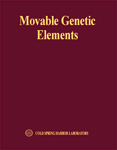|
XLV: Movable Genetic Elements 1980 |
|
|

|
From left: Dr. Barbara McClintock, Dr. Ira Herskowitz SYMPOSIUM SYNOPSIS LIST OF PARTICIPANTS CONTENTS OF SYMPOSIUM VOLUME PHOTOGRAPHS PUBLISHED VOLUME  |
Movable Genetic Elements
1980
Symposium Synopsis
Organizer: James Watson
In the early 1950s, Barbara McClintock's analysis of crosses between genetically marked corn plants led her to postulate that the activity of key genes was under the control of genetic elements that had the capacity to move from one chromosomal site to another. She called them "controlling elements," noting that when one was inserted next to a gene it inhibited that gene's activity. Conversely, when a control element moved away from a gene, the activity of that gene suddenly reappeared. Movement of control elements thus results in abrupt phenotypic changes, and, because of their high mutability, the respective genes they affect were first erroneously thought to be basically different from ordinary genes.
The idea that genetic elements could move with such facility from one chromosomal site to another flew strongly in the face of conventional genetic wisdom. Confirmation in other organisms thus had to occur before the far-reaching consequences of the corn plant message became generally appreciated.
Most important were the independent observations in the late 1960s of Jim Shapiro and Peter Starlinger that certain highly pleiotropic mutations in E. coli were the result of the insertion of descrete DNA segments (insertion sequences or IS's) that had the capacity to jump from one chromosomal site to another. Molecular characterization of these elements became possible soon afterward with the arrival of the restriction enzymes and the recombinant DNA cloning procedures. Quickly it became obvious that IS-like elements were to be found not only in bacteria, but perhaps in all organisms. Equally important was the discovery that closely spaced pairs of IS's can move as units ("transposons") carrying along the genes lying between them. Such transposons bore many similarities with the phage Mu, leading Ahmad Bukhari, Jim Shapiro, and Sankar Adhya to convene a meeting on DNA insertion elements at Cold Spring Harbor in May of 1976. With this meeting, IS elements and transposons moved to the center of the genetic world, commencing a frenzy of experimentation that has shown no sign of abatement.
Choosing "Movable Genetic Elements" as our 1980 Symposium topic was a virtually unavoidable decision, one that became even more appropriate after the invitations went out, when rumors began that the structures of integrated retroviruses were remarkably similar to those of transposons. So our most able Symposium organizers, Ahmad Bukhari and Jim Hicks, had great difficulty in keeping the number of presentations within the bounds of sanity. In doing so, they received invaluable advice from Sidney Brenner, Peter Day, Harrison Echols, J. R. S. Fincham, Walter Gehring, Mel Green, Ira Herskowitz, Lee Hood, Amar Klar, Phil Leder, Barbara McClintock, Howard Nash, Heinz Saedler, Jim Shapiro, Peter Starlinger, Jeff Strathem, and Bob Weisberg.
We were obviously most pleased that Barbara McClintock, who typically did not want to give a formal presentation, nevertheless gave an informal summary of her latest ideas. And most appropriately on the opening night, Bentley Glass briefly recapitulated many of Barbara's key contributions to genetics.
The formal program contained 103 presentations, to which the reports of 14 last-minute informal presentations have been added in these volumes. The total attendance at this Symposium was 302, a number which we handled with more ease than before because of great improvements in our food service facilities on the ground level of Blackford Hall. Our Meetings Office staff, Gladys Kist, Winifred Modzeleski, and Barbara Ward, were as usual indispensable in helping make our Symposium an enjoyable as well as a memorable event.
That we could invite so many participants reflects the substantial financial support again provided by the National Institutes of Health, the National Science Foundation, and the Department of Energy. Because of the rapidly escalating air fares, we needed still additional help, and we wish to acknowledge major support from the Cetus Corporation, Bethesda Research Laboratories, and New England BioLabs.
The preparation of the volumes is never a simple matter, and we are greatly indebted to our most effective Publications staff headed by Nancy Ford. In particular, we shall mention the most competent dedication of Douglas Owen, Nadine Dumser, Dorothy Brown, Doris Calhoun, Joan Ebert, Annette Kirk, and Kathleen Horan.
— Peter Sherwood
Search images: